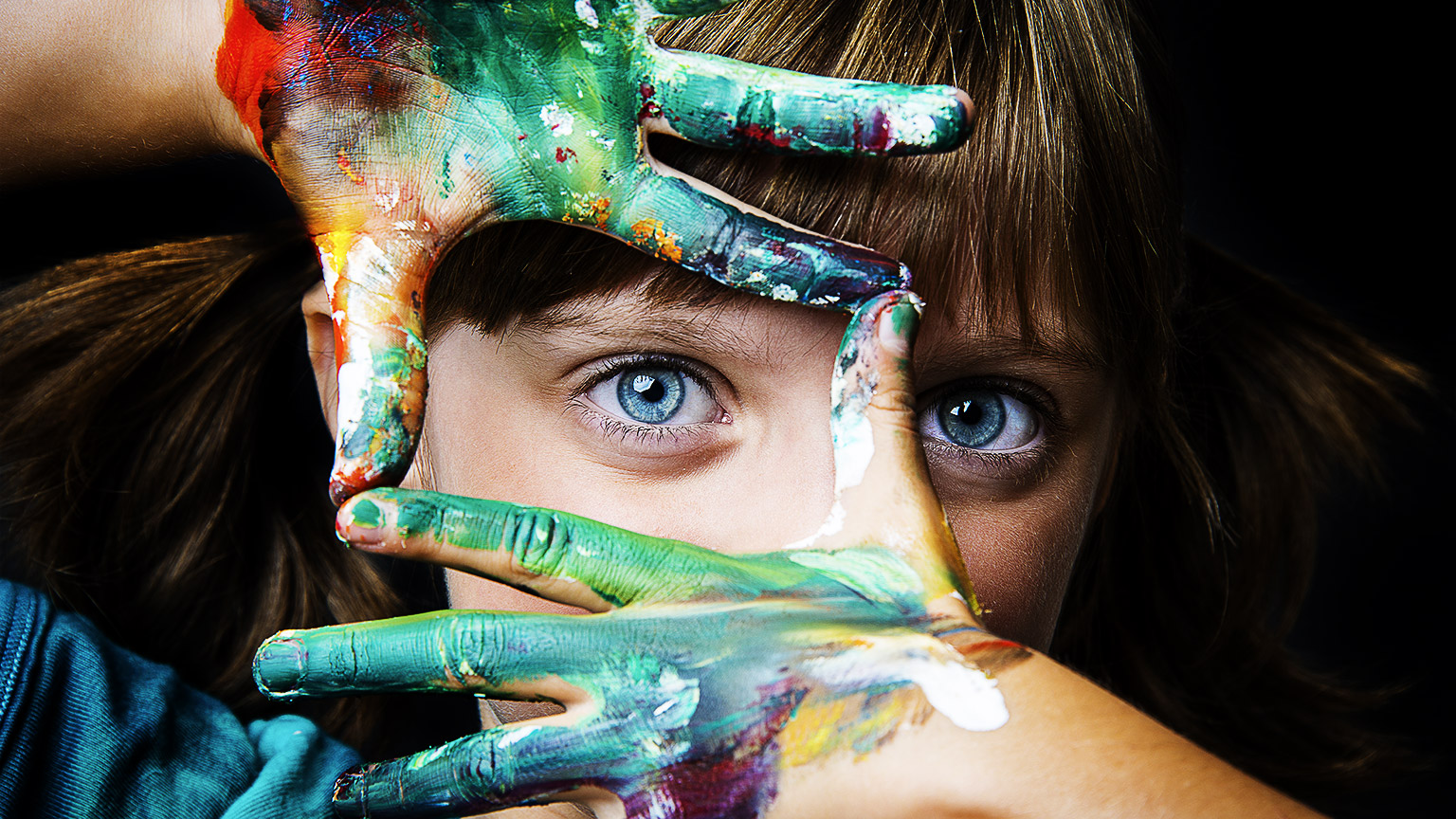A child’s creativity is individual and unique, building later-life skills such as divergent thinking, problem-solving, innovation, inquiry and discovery, and is heavily connected to sensory function. Nurturing creativity in children is also important to their sense of identity and emotional regulation and for fostering mental growth. Childhood is a time to inquire, investigate and test ideas, to build on the development of the brain and whole body.
By the end of this chapter, you will understand:
- Why creativity is important for children and society
- The importance of creative freedom and agency
- Types of creativity and relevant resources to engage children
- Strategies for supporting creativity in children
- Planning and evaluating the creative needs of children.
Creativity is everywhere, but the term itself can be conflicting and controversial.

Creativity is everywhere, but the term itself can be conflicting and controversial. Is creativity purely artistic? Can it include engineering, technology, innovation, mathematics, and science? In general, creativity is ingenuity – it is coming up with new ideas or ways of doing, creating, living, evaluating, managing, thinking, expressing and so on. Thinking about creativity this way helps build an understanding that creativity is a necessary skill to develop during childhood to lay the foundation for future skills in adulthood.
Freud stated that ‘every child at play behaves like a creative writer, in that he creates a world of his own, or, rather, rearranges the things of his world in a new way which pleases him’1. Through creative expression, children can verbally or non-verbally create a linkage between their unconscious, subconscious, and conscious thoughts through interpretation, which supports psychological growth and wellbeing. Many explain creative expression as a release, enabling children to self-represent, make ‘self-statements’ and discover themselves.
Creative elements include connections to all areas of development and encompass the whole child, woven through social and cultural elements of a child’s life and embedded into society through many or most roles in adulthood. Creativity, like play, is observed in all children, but often through variations of techniques and outlets. Also, like play, value-based feelings and perceptions about the importance of creativity vary from family to family and culture to culture.
Watch the following short video to learn more about the importance of creativity: Why Do We Need Creativity? by Child Creativity Lab.
Children use creativity to develop many skills, including:
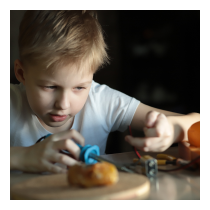
Exploration and experimentation
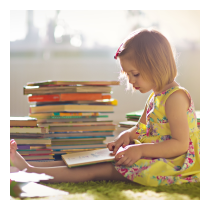
Language, communication, and literacy skills
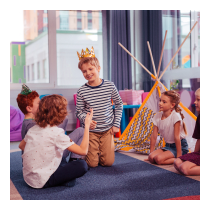
Social and creative competence

Research and self-assessment

Motor skills
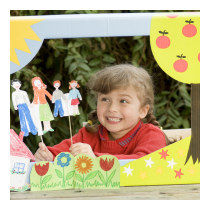
Role-play and dramatic play skills
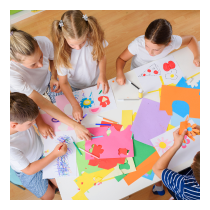
Mastery or emerging mastery
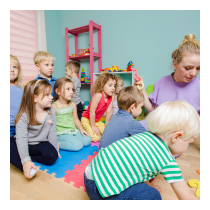
Symmetry, mathematics, and science concepts
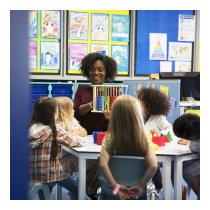
Directed thinking
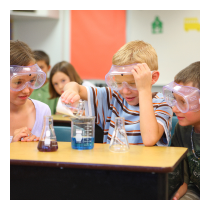
Divergent thinking and logical thinking

Self-regulation, self-concept, self-actualisation, and self-esteem

Technology concepts
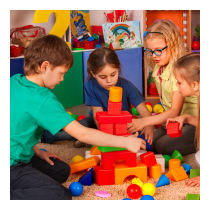
Engineering and constructions skills
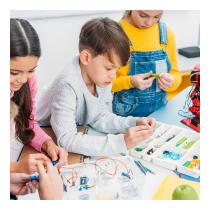
Reasoning Skills

Narrative competence, story recall and comprehension
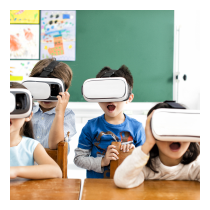
Ingenuity and innovation

Trial and error/problem-solving
Watch the following video and consider the broad spectrum of creativity and why it is needed for human endeavours: a-Creativity: i-Creativity by David Parrish from TEDx Talks.
Watch the following clip of Australian children expressing creative ideas about world problems: Unlocking the Power of Creativity by The University of Sydney.
Creative ‘behaviour’ often implies originality or that the product produced will be technically useful. However, the essence of creativity for children will usually be based on the individual’s unique perception of originality. For example, each child will complete something in different ways or create something new or with a unique aesthetic quality. Creativity, relating to children, is also based on the journey of creating, not the final result. Educators can promote creative processes by being interested in what children do and why and how they do it. Educators see the benefit of the creative process and are not necessarily concerned with the final product or if there is a final product. Educators understand the value of creative play and endeavours and promote opportunities for children to build confidence to experiment and explore.
Process Vs. Product

Through creativity, there can be benefits to both process-focused art and product-focused art. When creating product-focused art, a child begins the creation knowing what the product should look like (e.g., following a Lego design from an instructional booklet). On the other hand, process-focused art takes the child in an unknown direction that is completely open-ended, with no right or wrong way to complete the product (e.g., building with Lego without a booklet). Process-focused art allows for complete self-expression, full of discovery and creativity, benefiting self-esteem because there are ‘no rules’ or predetermined results.
Practice
Development of workplace and life skills
Consider the skills listed in this section that develops through creativity.
List FIVE adult careers or jobs that require these skills.
Make sure that you keep notes for your future reference, as this information will support you in your assessment and professional practice.
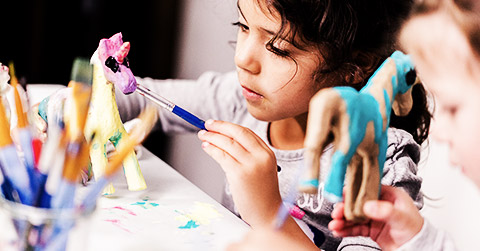
Case Study
Isabella is four years old and busy doing arts and crafts. She uses sticky tape to connect cups onto the top of a box, placing four cups securely with several pieces of tape. She cuts out a section of the egg carton to put onto the front side of the box. She then flips it over so that the cups are on the table supporting the box. One side is wobbly, so to stabilise it, Isabella adds another piece of sticky tape to the cup that she decides is causing the instability. She smiles as she realises she has solved her problem. Isabella turns to the educator, who has commented on the creation, and says, ‘I’m finished.’ She breathes in and out for a moment, looking at her creation. ‘This is my pig, you see. It has four legs and a snout nose.’ She stops and thinks a little more. ‘I was going to paint it pink like in the books and stories, but the pig should be able to choose what colour it is, don’t you think? I didn’t give him eyes either because he is sleeping, and you can’t see eyes when someone’s sleeping.’ Observing this moment, an educator may question internally what Isabella is making and why. The child considers and shares her experience of pigs and demonstrates this in her work. She uses divergent thinking to consider that the pig may not want to be generalised, and its colour can be decided in new ways in its own time. She also considers that when people sleep, you cannot see their eyes, which is how she justifies her decision to not give the pig eyes. She considers an element of creation that is ‘not working for her’ and solves the problem with self-pride, evident by her smile of success. The joy in her journey is that, when she began, she may not have had a plan for what she was making but decided what it looked like to her as she added resources that engaged or interested her. The journey for her created the result shared with the educator. She also may have had a plan to begin with or did not decide until the end what the creation was or what it meant to her, but her creative process and thinking is the focus of the journey. This is often how creative expression occurs.
Educators and families often find children from three to five years old think abstractly and creatively at different times, during different routines. For example, making characters and stories out of their sausages at dinner time or explaining that their pants can be put on sideways to give them a horse tail when getting dressed. As children reach around five years old, they begin to make more creations with a goal in mind and aim for their creations to look as ‘realistic’ to them as possible. They also become more concerned with what others think of their creative efforts. Children are naturally motivated to explore, discover, and create. They should be supported and encouraged to be creative, which will allow them the benefit of exploring real and imagined worlds.
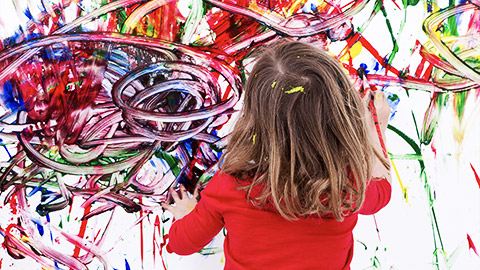
Creativity often takes time. It requires deciding which resources are available to use, which resources you want to use and whether you already have an idea of what you want to create or whether you just begin creating and see what comes from it or inspires you as you go.
Children often use trial and error to see what works and does not. They may often change their minds and, during social, creative experiences, may need time to organise or negotiate creative ideas and processes with others. When creativity strikes, it is important to give children ample time to play it out and create, with time for reflection and evaluation.
A 2018 report from the American Academy of Paediatrics (AAP) supports playful learning. It further develops research into the importance of unstructured playtime and the large-scale benefits it provides children’s health, wellbeing, and development. Allowing time for open free play to complete projects may be paramount to the project’s completion (or the creative journey).
Giving children ongoing opportunities to make their own choices is another way to support their self-esteem and motivation for creativity. They must be allowed to take the lead sometimes and follow their curiosity. When children know that they will be supported and facilitated in their creative endeavours, they are more likely to innovate as far as their imagination can take them. Learning for children can be enhanced when they are afforded control and agency over their creative decisions. In current curriculums, a shift has occurred from rote learning styles to planning for children’s innovation, application and transferable skills, looking towards their future needs and preparing them for adult success.
The need for children to have creative freedom and agency over their activities and processes is supported by the National Quality Standards and the learning frameworks. Outcome 4 (children are confident and involved learners) sees creativity as an essential learning attribute for children.
Developing children’s creativity can support and enhance their learning and development. Creativity can promote opportunities for children to learn problem-solving, innovation, risk-taking, and decision-making and increase their confidence. Providing children with creative freedom enables them to express themselves, try new ideas, innovate, experiment, and take risks. Creative freedom can include opportunities for unstructured play where the child is permitted to have agency to explore their interests and follow their curiosity.
Practice
Creative learning
View these creative images of children engaged in creative learning:

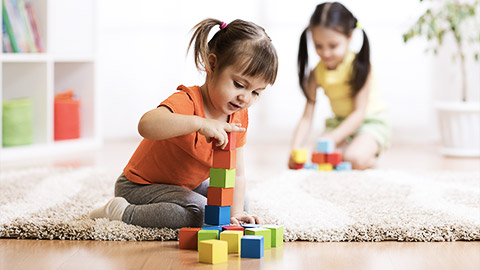

Make sure that you keep notes for your future reference, as this information will support you in your assessment and professional practice.
Write down the educational and creative elements of the experience for each image and answer the following questions.
Make sure that you keep notes for your future reference, as this information will support you in your assessment and professional practice.
- How have the resources been supplied and designed for engagement by educators?
- Why do you believe these resources were chosen?
- How do the resources allow children choice and agency?
- List the resources used. Consider other elements you might like to utilise to further encourage creativity.
- What practices would you use to ensure children feel emotionally and creatively supported?
One of the many upsides to creativity is that it has endless potential. There is an infinite number of possibilities and creative thoughts and journeys to explore. Many people put creativity into two categories: originality and functionality. However, the categorisation of creativity is an ongoing debate, especially regarding children’s creativity. One categorisation system, which John Baer devised, includes the following categories, or ‘domains’:
- performance
- entrepreneurship
- maths/science
- problem-solving
- artistic: verbal
- artistic: visual
- interpersonal.
In the Learning Framework for Australia, Outcome 4.1 2lists the different learning dispositions that children can develop as:
- curiosity
- cooperation
- confidence
- creativity
- commitment
- enthusiasm
- persistence
- imagination
- reflexivity.
Children can be provided with various rich enquiry-based opportunities to develop positive learning dispositions. Creative activities are a perfect vehicle that educators can use to encourage children’s imagination and curiosity and build their inquiry processes.
Developmental skills
Read the following scenarios and list all the developmental skills you can see at work in each one. Make sure that you keep notes for your future reference, as this information will support you in your assessment and professional practice.

Holly
Holly builds a cubby house out of a box, then attaches a second box for the roof, along with a milk carton for the chimney, and she paints flowers on the outside. She places pillows inside and invites her peer Suzie to join her for a ‘coffee’.
Lee
Lee constructs a high tower with magnetic blocks. He leans a slim piece of cardboard against the top of the tower, creating a ‘slide’. He finds a bowl to place underneath the cardboard ‘as a catcher’. He requests a marble or small ball from the educator and, using the slide, rolls the ball down the construction model to the bottom, where it lands in the bowl. He collects a small toy cat from the shelf and places it next to the bowl, and explains to his peer Thomas, ‘You see, the ball travels from the factory where they make the cat food, and it lands in the cat’s bowl, so he doesn’t have to wait to be fed. Now the cat eats the food!’ He tips the cat down to ‘eat’ the ‘food’.
Audio Visual Equipment and Technology
Technology can be creative, though in many cases, children cannot access the full set of available creative resources by using only online platforms to create. Children can use many arts, construction and story-building programs to exercise their imaginations and create their own worlds or designs. Children can also have creative and exploratory experiences making movies with technology or using photos captured on devices to build their art. Sometimes they just like to ‘tinker’ and sort the objects into categories or an order that makes sense to them.
Art Inspired by Nature Environments

Connection to the natural world can encourage children to appreciate nature and create from it, which will help develop their love of nature. When children have the chance to feel, smell and see the different objects nature has to offer, they can use their creativity to blend them into their creative worlds. Children can make objects from nature into imaginative mandalas or use them to enhance a play scene. In natural environments, children can make creative designs, explore, demonstrate curiosity, test and trial different techniques, and conduct experiments. They can draw into or construct with sand, create maps to track the movement of ant colonies, use water in creative ways, observe and draw birds in the trees or butterflies they see in the air (they may even imitate the creatures they see), create worlds and stories, and ‘bake’ mud pies. Even the weather can inspire children.
Practice
Are you creative?
Watch the following video on being creative. It may remind you of different learning styles or Gardner’s multiple intelligences theory. This is an important perspective when observing children's creativity and providing creative experiences.
Make sure that you keep notes for your future reference, as this information will support you in your assessment and professional practice.
Watch John Baer, Are You Creative? by The Brainwaves Video Anthology.
Next, write down a list of areas that reflect on your own ‘domains’ and rank how creative you believe you are in each domain: highly creative, moderately creative or less creative.
You may find it helpful to take this test based on Howard Gardener’s multiple intelligences theory to find out your most relevant ‘intelligence’: Website Multiple Intelligence Survey for Kids by Laura Candler https://scnv.io/pxqF
In many ways, Baer’s views are a broad way to look at creativity. Still, as Baer says in the video, much like in Gardner’s multiple intelligences or learning styles theory, you may be creative in all areas, a few, or you may also believe you are not creative at all. You need to delve deeper into the functionality of each type of creativity to determine your true strengths. Thinking holistically, many elements of creativity blend into other areas and encompass a collection of creative elements.
Watch the following videos to refresh your memory of Gardner’s multiple intelligences theory and different learning styles: Howard Gardner on Multiple Intelligences by Edutopia and Discover Your Learning Style by GCFLearnFree.org.
Culturally diverse art forms and artists
Children can be provided with opportunities to experience art forms from a range of diverse cultures. Educators will facilitate experiences within everyday routines and curriculum areas such as art, storytelling, music, and drama that explore the rich diversity of creative pursuits from other cultures.
Current research suggests that children exposed to art by artists from culturally diverse backgrounds increase their respect and acceptance of diversity. In addition, children from culturally diverse backgrounds can be provided with a voice using art and have increased levels of engagement.
Programs that promote inclusion could include:
- choose a country and explore an artist from that location
- look at where the country is located
- what season is reflected in the work
- what period is the painting from
- what is the same and different in the painting than in Australia?
- providing art materials in a range of skin colour tones
- display tables showcasing the diversity of children and people
- using a range of children’s literature from diverse cultures
- displaying posters, photo boards and wall displays that show cultural diversity in art and craft
- exploring similarities and differences in diverse art forms.
Aboriginal and/or Torres Strait Islander Peoples’ Art Forms and Artists

Aboriginal and/or Torres Strait Islander peoples have strong artist traditions of storytelling, dance, music, and art. Their art types include dot painting, rock carvings, bark painting, weaving, carving and sculpture. Different tribes have a variety of musical instruments. These include the didgeridoo, clap sticks, boomerang sticks, hollow drums, seed rattles and bull roarer.
Educators can embed Aboriginal and/or Torres Strait Islander peoples’ art forms and cultural elements into everyday learning experiences.
Aboriginal and/or Torres Strait Islander art can be shared with children, including:
- Music – listening to traditional and contemporary music, using clapping sticks or watching Aboriginal traditional or contemporary dance.
- Art – using natural materials such as ochre and material derived from nature to create artworks.
- Displaying local artworks, ensuring to use the correct and agreed attribution.
- Inviting local artists to visit and share their stories about their art.
- Displaying posters and images of works by Aboriginal and Torres Strait Islander artists such as Albert Namatjira, Emily Kame Kngwarreye, Minnie Pwerle, Clifford Possum Tjapaltarri and Gloria Tamerre Petyarre.
Children can be exposed to a wide range of art forms. Educators can present a range of materials to promote children’s individual expression. Children can be supported to explore and express themselves using interesting materials and mediums.
Music, Story Writing and Storytelling, Drama, Performance and Movement
Through music, movement and performance, children may demonstrate creativity, making up their own dances, songs, stories, and narratives. Children may play roles in ‘home corner’ such as feeding the baby, playing ‘doctors’ and making up puppet shows or plays. They may delegate roles and explain each character, what they do and even how they feel in certain situations. Imaginative play may represent fantasy or real life to demonstrate the story's complexity and situation. For imaginative play, drama and role-play, educators should allow children to explore various ideas and locations. These can be based on the children’s interests and experiences, such as going to a restaurant, a day spa, a friend’s home, the hospital or the vet; traversing indigenous environments and digging for fossils and archaeological artefacts, or camping with their family. Children can be encouraged to use props in their make-believe, such as dress-up, masks, and found items imagined to be something else. Recycled items such as cardboard boxes are versatile and can be imaged as vehicles, space helmets, cubby houses, rollercoaster cars, etc. You should also allow for exploring different themes, such as love, right vs. wrong, loss and fairness. Children often become interested in creating their own stories and may build on a particular story or repeat a story many times. The child may have created these stories or be an extension of an experienced story such as a fairy tale. Older children may enjoy writing their own stories and illustrating them. Creating ‘books’ is an effective activity for children of all ages, even pre-schoolers.
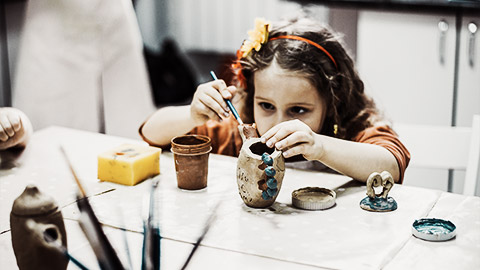
Art, Craft and Design
A range of art and craft resources help to promote creativity in children. Creative activities can be planned or spontaneous and use traditional art resources or odd bits and bobs, such as re-used bottle caps, tubes, and rocks. Children may draw, colour, paint, make collages, manipulate playdough or clay, create with papier-mâché, make beaded bracelets or other jewellery, create their own musical instruments, investigate sound in objects and created objects, or create with leaves and flowers. Their creativity is only hindered by the resources we, as educators, provide. Children may be interested in creating environments and building with wood, scrap material, clothes, or hats. Some children like to create a scene of different textures, such as placing various fabrics in an open spot and experiencing their different textures. Sometimes these pieces of fabric can become characters: The black fur becomes the bear; the corduroy becomes a deer; the piece of leather becomes a cow.
Construction and Engineering
Children often build and create beyond adult constraints: They make rooms out of shoe boxes, egg cartons or blankets; make rooms for the dog to sleep in; design their own spaces. When designing sets for their stories, children often use blocks such as Lego, Duplo, or wooden or cardboard boxes to represent locations. For example, inside a space rocket, truck, science lab, house or even a greenhouse for their flowers – there are no limits to a child’s imagination. Construction and engineering creativity results in children subconsciously practising science and mathematical concepts, such as measurement, symmetry and counting, to construct and design. It is easy to see how the domains of performance, maths/science and art can be incorporated within the creative process.
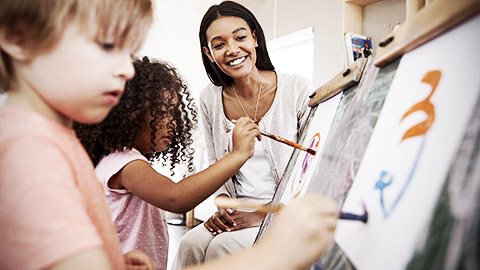
Supporting children with the development of creativity is about allowing them the time, freedom, and resources to design at will. The value of play and creativity must be evident and creating inclusive environments to honour children’s creative choices is paramount. A play-based and creative-minded curriculum helps to support opportunities for development and creative expression.
The Approved Learning Framework requires considering each child's learning needs and interests (Section 168). These guiding principles are applied when making decisions about educational experiences, including the rights and best interests of the child being paramount.
Educators use intentional teaching strategies that build on children’s strengths, interests, and needs. Educators make decisions about programming and learning opportunities that ensure children’s ideas and needs are considered in planning. Educators ask for children’s input, listen to their ideas and thoughts, and make decisions about actions that will support children’s learning. Facilitated experiences will acknowledge children’s cultural backgrounds. This focus ensures that the activity encourages children’s engagement.
Creative and play-based curriculums support children to:
- Examine materials from many perspectives, which enables children to explore the range of possible uses of objects and methods of organisation and classification
- Use a range of creative mediums for experimentation and self-expression
- Share experiences, stories, and items from their own culture
- Enhance their sense of efficacy by assisting them with translating their experience into meaning
- Gain competence and a sense of mastery over their environment
- Act on inspiration in creative endeavours (these may include creative provocations) by providing an encouraging, creative environment
- Play out thoughts, ideas, and life experiences within a mode of expression that is inherently theirs.
Providing Creative Provocations
Educators can provide open-ended opportunities for investigation, exploration, curiosity, and engagement to promote creativity in children. Creative thinking takes time. Educators can provide opportunities for play, problem-solving, making mistakes, building connections, and creating within an environment that is secure. Educators can also promote learning and engagement by providing aesthetically pleasing environments.
Educators should provide environments that remind children of various places within their community: their homes, the theatre, the library, the museum, or the art gallery. These stimulating environments can encourage children to tap into their own ideas, creativity, individuality and lived experience.
Role Modelling, Praise and Encouragement
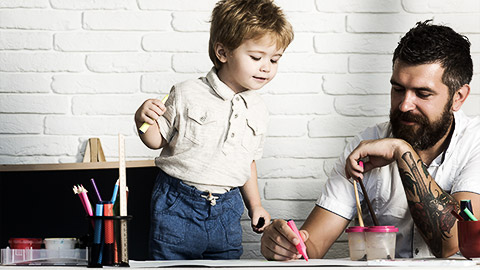
By displaying and encouraging genuine interest, respect and excitement for children’s creations, educators promote self-esteem and confidence in the children and communicate support for continued engagement in creative endeavours. Educators should use modelling, encouragement, guidance and ideas for ongoing support and mentorship opportunities when required to minimise any frustrations in the children’s creative endeavours. For example, children can be encouraged to problem solve and find creative solutions if they cannot find what they need, planned action is not working, or one material will not stick to another material. This will aid in keeping the child’s creative energy flowing.
By asking questions and encouraging children to find the solutions and answers, educators promote agency and competency, demonstrating that they believe the children can do things themselves, deal with their own issues and dilemmas, and have the tools to self-manage problems. It also encourages children’s ongoing critical thinking and problem-solving skills.
Educators can engage with children and invite them to share about what they have created. This can include asking them open-ended questions to provide a platform for discussion. Open questions are asked so the responder can provide more than a yes/no or one-word answer. Quality open questions invite detail and provide choices in how the child wants to answer. They will often be how what, or why questions. Open questions are a useful tool to begin a discussion and direct the focus of the conversation. They show that the educator is interested and is making time to value the children’s creativity. Children can be invited to present their created work to the group and be allowed to talk about it.
Examples of open questions include:
- Tell me about how you made it?
- Where did you get that idea?
- Why did you choose that material?
- When did you know it was finished?
- What else could you do?
The educator displays respect for the child's endeavours in creating their work. They can express admiration for the creative work to demonstrate esteem for the child’s efforts. This respect can be further demonstrated by seeking permission from the child for what they would like to do with the created work. This promotes agency and ownership for the child, by inviting input about how, where and what the child would like to happen to the work. Do you want to share the work with the group? Does the child wish it to be displayed? Will it be added to the child’s portfolio of work? Does the child want to take it home? Is this the first attempt, and further development is needed to create a final product?
Similarly, children can be encouraged to respect the work of others and to admire their creative efforts. Educators can promote self-esteem, social skills, confidence, empathy and interest in others and peer relationships by encouraging children to discuss their creations with others and ask questions, as well as encouraging peers to inquire about the creations of others. This also promotes collaboration where children can share perspectives and ideas and spark others’ imagination. Educators can encourage respect by supporting children to make positive and developmental comments about each piece of work they critique. Children can be encouraged to consider what they say regarding the creative work of others before they say it and to reflect on how they would feel if someone said the same about their work.
Allowing children to have agency and autonomy will also teach risk management, self-awareness, and safety awareness. Educators promote and encourage agency and autonomy by allowing children to choose their own resources and materials. In doing this, they demonstrate their support for creative endeavours, giving the children the confidence to search for the resources they want and need and, if the resource is unavailable, to ask where it can be sourced or find a creative alternative to use.
Educators can use strategies that model creativity by improvising with equipment and materials. Children can be introduced to ways that artists and others use their imagination when being creative. They can encourage children to experiment with different ways of expressing ideas and meaning with a wide variety of media or open-ended materials. Educators can model their own creativity and demonstrate that creativity is valued. Educators can demonstrate that they welcome the wide possibilities of how others see and use their creativity. They can encourage children to look at the many ways that something can be achieved and the different ways that something can be approached and interpreted. Creative, intentional teaching requires educators to see and welcome possibilities.
The educator can share different mediums and methods or show how others have approached the same thing but in their own way. For example, the educator can show how each architect has designed a building for shelter but that every building is unique and personal to the creator’s own expression. Children can be introduced to the idea that there is no one way and that everyone’s way is valuable and unique. The educator can also model how problems and barriers can be addressed to lead to better solutions and outcomes.
Educators sometimes need to guide, support, and teach children how to safely use various resources and equipment, especially if they have not used them before. It is important to structure experiences safely and ensure that all materials selected are safe for each child's use. Educators will consider allergies or medical conditions, such as foodstuff allergies, should you intend to use food as a material. You should also ensure that the materials' size, weight, and design are age-appropriate and safe for the children to use.
Educators should encourage children to seize ‘aha!’ moments and then reflect on them together. Take the time to appreciate the moment – creativity can be both exciting and soothing.
Using Critical Reflection

Educators must consider whether they are presenting children with open-minded approaches and reflect on children's perspectives by viewing things from a child's point of view. Critical reflection is a process of reviewing, questioning and assessing beliefs and practices to make decisions that will enhance future practices. You should question whether children would think a theme or subject is interesting, whether they could create something with the theme or subject, whether they could have their curiosity sparked and would want to do a particular activity, and if not, why not? Sometimes, an object an adult may find rather uninspiring can encourage a child's creative play and learning experiences. Educators should carefully observe what children find interesting and use their observations to plan future opportunities for creative expression.
Critical reflection assists educators in identifying areas of development and provides an opportunity to build their knowledge and skills. It should be conducted regularly to explore the educators’ thoughts, feelings, and experiences. It is a valuable method for extending and refining professional practice and informing future development.
Reflection involves thinking openly and analytically about key topics or questions that focus on the reflection. The insight educators and other staff gained during critical reflection can improve the quality of the service's practice. Meaningful information recorded during the reflection can also be shared with other stakeholders, such as families, to include them in the reflection and improvement of practice. Reflection aims to be meaningful by involving thoughtful and analytical thinking focused on improving the educator’s practice
Educators use critical reflection to identify the need to acquire new knowledge and make positive changes to practice. Reflection enables the team to openly discuss success and areas for improvement using positivity and support.
Meaningful reflection occurs when quality information is gathered in response to key questions about what has occurred and why. It also considers the bigger questions of who is and is not advantaged by the practice if it continues.
Meaningful reflection includes:
- thoughtfully exploring different aspects of a topic, including:
- the reasons that decisions were made
- whether and how the service's philosophy is reflected in the decision or practice
- what were the outcomes of the decision or practice?
- thoughtfully considering a range of perspectives on a topic, including the way that practices impact children and families
- part of an established routine and conducted regularly to become an essential part of the culture of the service
- others being involved in facilitating the sharing of ideas, giving feedback, and debating on areas that are unclear or could be improved or developed to contribute positively to practices.
Resources for Creativity
You should try to provide a range of resources: both man-made and natural materials; different colours, shapes, textures, sizes, themes, and collections; loose parts; everyday items; and bits and pieces. You should also try to provide a variety of tools as well as inspirational materials and objects: art magazines, pictures and posters, appropriate theatre promotions, sand sculptures created in competitions, architecture, famous sculptures and paintings, flowers, photos of children, and home and garden magazines or images.
The selection of resources can also focus on sustainability. This includes choosing items that are responsibly sourced. Items and equipment that are sustainable are re-used, renewable, recycled, or organic. Educators can become aware of available sustainable natural materials and non-toxic products. Educators can use vegetable dyes and pigments made from fruit and vegetable extracts, play dough made from flour and oil, vegetable starch glue, and bees wax crayons. They can also reduce plastics and single-use items and replace them with re-used or renewable options.
Play areas should be equipped with a wide variety of stimulating text and imagery, including reading and writing materials relevant to the curriculum and children’s interests, such as written music, multilingual text, and newspapers (new and old). These kinds of text and imagery can support creative ideas and exploration that children (or educators) may not have considered previously.
Providing a variety of intriguing elements encourages children to think about how they may be used. Still, everyday items with which children are already familiar can also be highly intriguing if they have not yet been given the opportunity to utilise them for their chosen purpose.
These resources may include:
| Household Items | Household items include pots, pans, utensils, crockery, aprons, towels, mirrors, cookbooks/books, maps, telephone books, folders, and clipboards. |
|---|---|
| Reusable Items | Reusable items include cardboard boxes of all sizes, cleaned/safe packaging (such as food boxes, shampoo bottles, jars, and containers), beads, tubes, paper, string, blankets, bottle caps, unused plastic or paper cups, and cutlery, carpet, fabrics, cards, frames, jewellery, and clothes (where appropriate), wrapping paper, nuts and bolts, buttons, pieces of wood, sticks, leaves and timber, and ribbons. |
| Hardware Items | Hardware items can be recycled old computers, printers, tools, bike or car parts, and phones (for role-playing or deconstruction if age-appropriate for the child). Any hardware items used must be safe and appropriate for the children's ages. |
| Loose Parts and Open-Ended Materials | Loose parts and open-ended materials are essentially random found objects that can be used in any way and for many different play opportunities or ideas. It is no singular required product. The beauty of these items is that there are endless possible end products. Hence, utilising them for children’s creativity is about allowing children to engage in the creative process and a journey of discovery, imagination, and innovation. Open-ended and loose part materials may include such items as wool, material pieces, stones, sand, pinecones, feathers and seashells, parts from technology or machines, pieces of wood, nails, tools, and household objects such as hair rollers, sponges, keys, whisks and measuring cups. |
| Art-Related Items | Art-related items include different paint brushes, paint pallets, clay, sponges, printing stencils, stamps, stickers and other items that could be used for art projects, such as string, marbles, balls, |

Children will typically be interested in various types of pencils, markers, crayons, pastels, charcoal, and chalk.
You could provide various types of playdough: coloured, scented, textured and uncoloured. Children may also want to use clay or plasticine, or papier-mâché. The tools and resources for manipulative creativity are almost endless and include a range of scissors, glues, cutters, and knives (which must be age/ developmentally appropriate).
Watch
To learn more about loose parts and open-ended materials, watch the following video: Open-Ended Play Ideas | How We Do Open-Ended Play and Loose Parts by This Family Thing on YouTube https://scnv.io/R96R (23:43 minutes)
Resource
Visit the following link to read more about using loose parts in children’s play: Resources for Playing – Providing Loose Parts to Support Children’s Play: A Toolkit by Play Wales https://scnv.io/gNWO
| Dramatic Play Items | Dramatic play items include boxes to use as a stage, blankets and curtains, puppets and puppet-show boxes, a variety of themed and cultural dresses, a wide selection of music, household and reusable items and small world items. |
|---|---|
| Construction and Technology Items | Children may use various construction items such as wooden, plastic, and magnetic blocks. They may want to use tools to construct 2D or 3D pieces with reusable items. Technology may be used to film and tell stories, take photos, and use child-friendly creative apps. Science-Related Items. |
| Science-related experiences |
Children can explore and experiment with a variety of materials and activities. These can include:
|
Tip
It can be highly beneficial to partner up with local artists, potteries, theatre or dance companies, construction businesses, architects or other community groups for community projects or experience days to encourage children’s creativity.
Practice
Provisions for creativity
Read the following scenarios and answer the question at the end. Make sure that you keep notes for your future reference, as this information will support you in your assessment and professional practice.
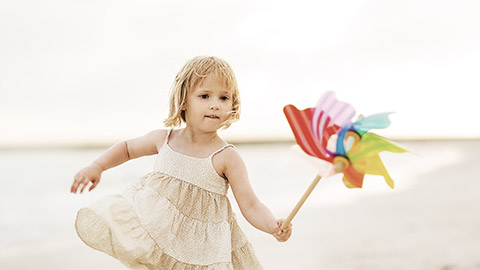
Jamila
Jamila, who is five years old, is trying to make a bird she made with paper ‘fly’ by placing the bird on top of a stick. She attempts to tie the bird to the top of the stick with string. The bird is flimsy and will not stay on top of the stick like she wants, as the string makes it fall. Observing and reflecting on the moment, the educator realised that Jamila was beginning to lose interest due to frustration. They decide to put forward an idea to support Jamila’s creative process: ‘I have an idea. Do you want to hear my idea?’ Jamila sits up straight, paying attention to the educator, clearly eager to hear the idea. ‘Some wire might work. I have some here. What do you think?’ Jamila nods and begins to manipulate and experiment with the wire, looking back and forth from the wire to the stick and the bird. Jamila says to the educator, ‘It’s a bit harder, but bendy too. I think it will work – can we try it?’ The educator cuts some wire to use, curls the ends to ensure they are not sharp and explains to Jamila how to use it safely. Jamila then uses the wire to successfully attach the bird to the stick. Jamila sits proudly, staring at the flying bird in the breeze with a big smile on her face. ‘Look at it go!’ she shouts. The other children gather around her to watch the bird ‘fly’ and ask Jamila questions about her creation.
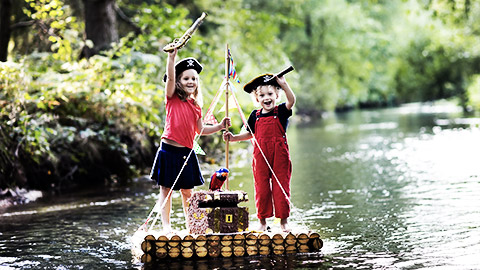
Izzy
Izzy, who is four years old, is looking through the reusable items box and finds some pieces of different-sized packaging cardboard. She gets each piece out, examining its size and shape. Once she has pulled out all of the cardboard, she begins to place the larger pieces parallel to each other on a mat. She looks at her creation for a few moments and then takes the thinner, longer pieces and places them over the top of the large ones, forming a bridge-like structure. She claps once and smiles, then looks up and moves over to a shelf holding a variety of different characters and small world items. She chooses a small stick, some felt and a piece of black faux fur. She places the blue felt beside the cardboard pieces, then pokes the stick into and through a small cardboard box and puts the black fur on top. She gets up again and picks up a shark, a turtle, a felt fairy, a pirate and two wooden people. She places the people in the middle near the pole, the fairy on top of the pole and the animals on top of the blue felt. She then takes a big breath in and out and sticks her pointer finger into the air because she has an idea. She chooses a small piece of cotton and wraps it around the pole loosely.
Izzy begins to speak, ‘Ahoy, me matey! Do you see the sharks over there, fairy?’ Her voice becomes higher pitched as she picks up the fairy, ‘No, I only see turtles. How scary! Don’t worry. I will protect you all with my magic.’ This narrative plays out over the next 15 minutes. After Izzy is done playing out the scene, she gathers a clipboard with a piece of paper attached and a black pencil. She lies on her stomach on the mat and draws the scene. She then sits the drawing on the clipboard against the window and encourages other children to explore her ‘adventure’.
Practice
Selecting creative supplies
Walk around your home and outside with a basket or bag and collect intriguing items you find. Once you have found at least SIX items, consider each one as a potential object for use in a creative endeavour for children.
Make sure that you keep notes for your future reference, as this information will support you in your assessment and professional practice.
For each item, ask yourself:
- What is the object? Is it safe, and if so, for what age group?
- How may it be used? (You could try creating as many things as possible with the objects yourself.)
- How would you provide it to children (e.g., in a mixed bag of ‘oddities’)?
Tip
There are many inspiring ideas and items out there that could be used to encourage creativity in children – you just need to find them!
Research different sites and create a portfolio of creative ideas for children, so you have a bank of creative projects or opportunities ready to go for different ages, skills and interests.
For the first two entries in your creative portfolio, you could add making stress-ball people and zentangles. Watch the following videos to find out how:
How to Make a Stress Ball by Red Ted Art.
Zentangle for Beginners – Step-by-Step Tutorial for How to Draw a Zentangle by Mr New’s Art Class on YouTube (30:01 minutes)
Planning for Creativity
When planning for creativity, it is important to consider the outcome or goal you are hoping the child will achieve, as creativity has many outcomes. Creativity is very individual, and the journey is just as important, if not more important, than the result. If considered in terms of the approved learning framework, Belonging, Being & Becoming – The Early Years Learning Framework (EYLF) for Australia, educators may aim for children to have outcomes such as:
- A stronger sense of identity
- A sense of connection with and contribution to their world
- A stronger sense of wellbeing
- Increased confidence and involvement in learning
- More effective communication
Creative experiences can be structured to encourage and support children to achieve any of these outcomes, generating a wealth of benefits for the child. Creative experiences can use active learning in which children participate in the learning process, think for themselves, pose questions, and answer them, so they fully engage in their learning.
Children can be supported to develop aesthetic values when engaged in creative pursuits that build an appreciation of the arts, nature, and beauty. This includes presenting a physical environment that children can appreciate for being aesthetically pleasing. This supports the theories of Reggio Emilia and Rudolf Steiner, where the planning of the space aims for beauty, harmony, and engagement by using light, colour, space, and style.
Planning also considers strategies that are culturally aware and sensitive. These aim to be inclusive of children and families who come from diverse cultural backgrounds. Educators can build ‘cultural competence’ by continuously learning about, reflecting upon, and finding ways to better support culture to support the identities and culture of all children and their families. Educators will demonstrate a value for diversity and the richness and creativity it brings to society.
Planning can use a wide range of creative ideas and opportunities that foster wonder and curiosity in children. Children can be allowed to explore, experiment, create and follow their interests. This can promote learning.
During creative play, children can develop literacy, including extending their vocabulary and exploring new language and concepts. Children can be asked to describe experiences using new descriptive words that build their vocabulary. Rather than describing a mud pie as wet, the child can be encouraged to describe how it feels and use words like icky, sticky, and gooey. Educators can share books that expand the creative process, such as Beautiful Oops? By Barney Saltzberg and The girl that never made a mistake by Mark Pett.
Resource
Visit the following link to refresh your memory on the EYLF outcomes:
Transcript of The Early Years Learning Framework – Outcomes3
Some benefits related to children becoming more involved in learning are that the children:
- Develop dispositions for learning such as curiosity, cooperation, confidence, creativity, commitment, enthusiasm, persistence, imagination, and reflexivity
- Develop a range of skills and processes such as problem-solving, enquiry, experimentation, hypothesising, researching, and investigating
- Can transfer and adapt what they have learned from one context to another
- Can resource their own learning through connecting with people, places, technologies and natural and processed materials.
When planning creative opportunities for children, it is important to consider the who, what, why, when and how.
Review the following template that can be used for planning creative opportunities.
| Area to Consider | Definition |
|---|---|
| Who | Which child/group are you planning a creative opportunity for? |
| Why | Why are you planning a creative opportunity for this child/group? (This should be specific and reflect previous observations or teacher-initiated concepts related to the child/group’s current needs.) |
| What | What will the experience be? Will it be delivered through intentional teaching, opened-ended free exploration and/or active learning? What do you want the child/group to achieve through the creative process (investigate, problem solve, express themselves, build a sense of ownership)? Do you want the child/group to work alone or collaboratively with others? Is a sink required for handwashing and cleaning? Is a table, mat, sandpit, etc., required? |
| When | When will the experience be available to the child/group? Will it be an ongoing project or take place in the morning or afternoon of a particular day? |
| Where | Where will the experience take place? Will it be indoors, outdoors, or moved between or available in both areas? |
| How | How will the creative opportunity be carried out and made available to the child/group? How will the educators facilitate it? How will you utilise the approved learning framework’s practices and principles? How does it encompass the service's philosophy or service you work for? How does it meet national regulations for program and practice, health and safety, physical environment, relationships with children and the general wellbeing of the children? How many staff will you need to help facilitate and supervise the activity? How will it be inclusive for all children? Consider how you set up the experience impacts whether the children are drawn to it and become engaged in the experience. |
Providing Time for Children’s Creativity
The Approved Learning Framework recognises that children’s learning is achieved over time. Children can benefit from practising new skills and extending their ideas. A child-centred program allows children’s creative projects to extend over time, rather than having a finished product at the end of a session. This encourages children to take ownership of the process and to extend their learning.
Curriculum development recognises that children need to eat, drink, have breaks, participate in rest times, and go home at the end of the day. So, there will be times when children need to pause a creative project and trust that they can come back to it at another time (and that it will be carefully guarded to ensure its protection until they return). Planning for creative activities can include allocating large blocks of time so efforts can be extended over days or weeks.
Educators can support children’s creative pursuits to be ongoing by adjusting planned activities to another time. When they run out of time, children can be asked to make their own choices about how they wish to manage a project. They can be supported to share their extension ideas in pictures or notes that the educator records for later use. Creations can be left in place with a ‘work in progress’ sign, or children can take a picture of the area so they can recreate it on another occasion.
Maintenance and Care of Materials and Equipment
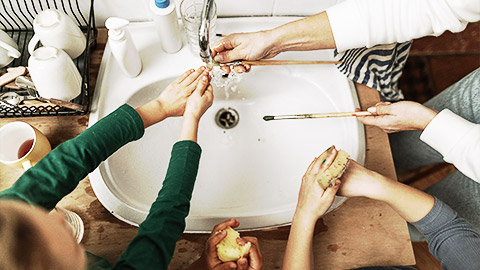
Children’s agency can extend to the entire creative process, from making decisions about what to do; to taking ownership of selecting materials; and setting up the area. Children can be encouraged to take ownership, including taking precautions such as laying a protective cover on a surface, cleaning up spills, and correctly using equipment. Children can be supported to exercise care with materials and equipment, such as not overloading a paintbrush to prevent drips, drying a paintbrush with a towel to preserve the bristles, and storing play dough in an airtight container to prevent it drying out. Children can be encouraged to help with clean-up activities once the activity is finished. This can teach them about sustainability practices such as re-use and recycling.
Collaboration Opportunities
Collaboration can focus on communication and social interaction between children to share ideas and gain shared meaning during creative activities. Children can be encouraged to discuss with each other their plans and actions to extend their ideas and gather others' input. Collaboration can also extend to creative collaboration, where children work jointly using open-ended mediums. For example, children may be encouraged to draw, paint, or build with another or in a small group. Children can learn from each other, become more innovative, and build shared meaning. Children can enjoy the activity where it offers both an opportunity to create but also social play and learns from others.
Use Creativity to Overcome Challenges
Creativity can be used to encourage children to build skills in decision-making, problem-solving and critical thinking. Children can be given agency and control to work through challenges. For example, when building a box tower, the child can be asked how they could prevent it from becoming top heavy and falling. They can be supported to problem solve and come up with innovative solutions. They can be encouraged to enjoy the journey of creating rather than trying to make something perfect. Children are comfortable with iterating solutions. This is the principle behind design thinking that can assist them in problem-solving as adults.
Children can be invited to explain their thought processes as they overcome challenges. This can be done using questioning and exploring options. This builds children’s confidence that they have ideas and options to explore and are engaged in a valuable process.
Use Flexibility
Flexible approaches will allow children to express themselves and explore their interests. Flexible planning allows the program to be directed by the children’s needs and interests. A flexible approach permits for children to be creative. Flexibility allows educators to respond to children’s strengths, interests, and needs.
The educator can be open-minded and open to a variety of possibilities. Educators will:
- be aware of being overly restrictive or prescriptive about how materials and equipment need to be used
- be flexible with the timing of activities to allow them to be child-led
- be open to new and unusual ways to use items
- avoid activities and equipment that are prescriptive and can only be used in one way.
Educators can respond creatively to build on children’s imagination when they observe them displaying an interest. For example, if a child is interested in playing in the kitchen corner, a flexible educator could ask them how they would like to extend their interest. The usual lunchtime routine could be adapted, so it is a café-style lunch, or a master chef event could be organised. The child could make menus and research foods to ‘serve’. A local chef could be invited to visit the centre.
Practice
Planning creative opportunities
Read the following scenario and follow the instructions at the end:
A Creative Plan
In the room for three-year-old at Little.ly Early Learning Centre, the children have been collecting leaves from various trees on their walk into the service each morning. When they enter the room, the educators investigate the leaves with the children in group discussions. They examine the leaves' texture, size and structure and discuss the children’s questions about leaves and trees. The educators decide to build and extend this interest in learning about trees by examining the life cycles of trees and plants with the children.
Make sure that you keep notes for your future reference, as this information will support you in your assessment and professional practice.
Select desired outcomes for this scenario.
- Make a plan for different activities using the table template included in this section. Include a plan for:
- A construction experience
- A dramatic play experience
- An imaginative play experience
- A movement and music experience
- A visual art experience
- Include an element of digital technology in one of these experiences.
- Draw a picture of what each experience looks like in your mind. (Record ideas freehand or use a template from the service in which you work or have a placement.)
Answer the following questions for each experience:
- How will you use critical reflection to prepare for the experience?
- What will the roles of the educators be, and what provisions will they facilitate?
- What will you be looking for when you observe the experience?
- How will you know if the outcomes have been achieved?
Evaluating Creativity
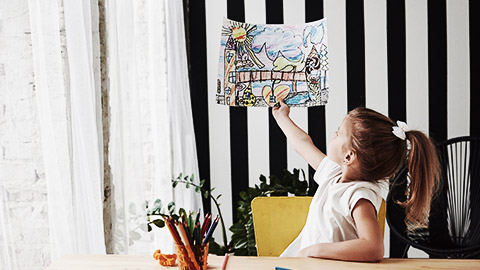
An important consideration when planning for and evaluating creativity in children is that there is no wrong or right in creativity. The educator is not there to judge the final design for artistic merit. Instead, they must observe how the child used critical and creative thinking, what they did and with whom and why they created that piece. They must also consider whether there was a positive outcome for the child and whether they were able to help the child reach the desired outcome for which they had planned. The educator should ask themselves: Did the child enjoy and develop a skill through the creative process but not reach a specific outcome, or was the experience of the creative process, in fact, the outcome?
Educators must continually reflect on their own planning and evaluating skills and processes. They should assess both the process a child uses, and the product/outcome related to the child’s goal.
Practice
Evaluating creativity
Read the following scenario and answer the related questions:
The Nature Experience
You want to implement a small world play (dramatic play and imaginative play) experience using a variety of leaves and objects collected from trees around the service. You choose the learning dispositions from the NQS Outcome 4 4: Children are confident and involved learners as the desired outcomes for the children engaging with the experience:
- Develop curiosity, cooperation, confidence, creativity, commitment, enthusiasm, persistence, imagination, and reflexivity
- Develop problem-solving, enquiry, experimentation, hypothesising, researching, and investigating skills.
- You then develop a plan for the experience.
Make sure that you keep notes for your future reference, as this information will support you in your assessment and professional practice.
| Who | The experience will be for the whole class. |
|---|---|
| Why |
For the children to work towards the following
|
| What and where |
The activity will be set up in a quiet corner of the room around the standing tray with space for three children. There will be various leaves on the tray and, next to the tray, a small shelf with
On a small table on the other side of the tray, there will be
There are leaves on the window behind the tray so that the children can see the sunlight shining through the leaves, revealing their translucency |
| When | Every day over two weeks as an ongoing experience (could be further extended) |
| How | No extra supervision needs are required for this experience. |
You have implemented the plan that you created above. Read the information below and identify how one child named Jamie, who is three and a half years old, interacts with the activity. You make the following observations:
Jamie makes his way to the nature tray as soon as he appears to observe it. He stands and looks around at the tray, the small table, and the shelf. He places his hands on the tray and underneath the leaves, moving his hands around in circles under the leaves. He takes one leaf and holds it by the stem, spinning it around with his thumb and pointer finger, watching it as it turns. He looks at the leaves on the window and then back at the leaf in his hand. He then holds it up to the window, where he twirls it some more. He places it down carefully on the tray, then picks up another leaf and does the same thing. ‘Hmmm,’ he says. He repeats the action with five leaves and then places them in a line in order of colour before moving away from the table.
How would you interpret this observation? Make sure you record your answers to use them for future reference, as this information will support you in your assessment and professional practice.
Ask yourself the following:
- Is Jamie working towards or has he achieved any of the desired outcomes? Was there any kind of positive outcome? How would you evaluate the outcome?
- Put yourself in Jamie’s shoes and try to view the experience through his eyes. What happened? What did he learn? What did he achieve?
- Do you think Jamie enjoyed and learned something from the experience? Would you consider it a success?
